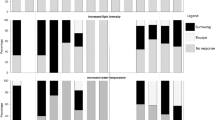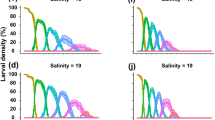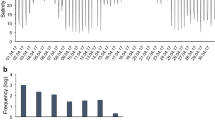Abstract
The brackish water bivalve Corbicula japonica, a target species for seedling release in Japan, inhabits environments subject to drastic salinity changes. The burrowing behavior of C. japonica in sand decreases predation. To improve their survival after release, the effect of salinity change on the burrowing behavior of adult C. japonica was observed in tank experiments. We found that salinity changes had a significantly negative effect on burrowing behavior, while acclimatization to constant salinity had a positive effect. No burrowing behavior was observed even after 24 h when the salinity change was large (range: ±25), whereas individuals burrowed within 0.56 h when the salinity did not change (range: 0). We estimated that, when there was no acclimatization period to a constant salinity, the range of salinity change for which burrowing was common was −4.7 to +9.9. We conclude that acclimatization to the salinity of the release site effectively promotes quick burrowing and, consequently, the survival of C. japonica after release. Alternatively, the production areas should have the same salinity environment as the release site.





Similar content being viewed by others
References
Aishima N (1993) Effects of water temperature and salinity on burrowing behavior in juvenile short-necked clam Ruditapes philippinarum. Bull Fukuoka Fisheries Mar Technol Res Cent 1:145–150 (in Japanese)
Asahina E (1941) An ecological study of Corbicula japonica group, the brackish water bivalve, with special reference to the environmental factors of its habitat in Hokkaido. Nippon Suisan Gakkaishi 10:143–152 (in Japanese with English abstract)
Bertrand C, Devin S, Mouneyrac C, Giambérini L (2017) Eco-physiological responses to salinity changes across the freshwater-marine continuum on two euryhaline bivalves: Corbicula fluminea and Scrobicularia plana. J Ecol Ind 74:334–342
Folk RL, Ward WC (1957) Brazos River bar; a study in the significance of grain size parameters. J Sediment Res 27:3–26
Fuji A (1957) Changes in tissue chloride and physiological activity of the brackish-water bivalve, Corbicula japonica, in response to variations in salinity. Bull Fac Fish Hokkaido Univ 8:163–177
Hayashi H, Iwamoto T, Kondo M (2012) Distributions of water qualities, tidal-bed materials, and a brackish-water mussel Corbicula japonica in the tidal flat of the Yoshii River. Bull Okayama Pref Tech Cent Agri Forest Fish Res Inst Fish Sci 27:5–11 (in Japanese)
Higano J, Yasunaga Y (1986) Examination of sand-mud bottom substrate II—basic research on burrowing behavior of Meretrix lamarckii and Macridiscus aeuginosa. Tech Rpt Nat Res Inst Fish Eng 7:41–52 (in Japanese)
Ishida O, Ishii T (1971) Resistance to salinity in Corbicula japonica. Aquacult Sci 19:167–182 (in Japanese)
Kaito S, Suzuki T (2000) Ishikari River. In: Nakamura M (ed) Japanese brackish water clam fishery—current situation and problems. Tatara Syobou, Yonago, pp 65–73 (in Japanese)
Kajiyama M, Ozaki M (2006) Distribution and abundance estimation of brackish-water clam Corbicula japonica on Tone River. Bull Chiba Pref Fish Res Ctr 1:7–18 (in Japanese)
Katayama A, Ito K, Katayama S (2015) A field experimental study on the effect of salinity and temperature on the growth of caged Corbicula japonica (Mollusca: Bivalvia). J JSCE Ser B2 Coast Eng 71:23–29 (in Japanese with English abstract)
Kobayashi Y, Sasaki T, Ishikawa T, Minoura Y (2010) Seasonal variation of bottom sediment characteristics in the Tone River estuary. Ann J Hydraulic Eng 54:679–684 (in Japanese)
Kohama T, Hata A, Mimura K, Fujitani N (2013) Water quality and the number of bacteria in estuarine water of Tone river. Univ Bull Chiba Inst Sci 6:7–11 (in Japanese)
Kojima E (1978) Effects of environmental changes (salinity) on Corbicula japonica—VI (mortality). Rep Freshwater Fish Exp Stat Chiba Pref 2:38–42 (in Japanese)
Kuwahara H, Saito H (2003) Behavioral characteristics of Corbicula japonica planktonic larvae downstream of the Hinuma River. Proc Coast Eng 50:1106–1110 (in Japanese)
Maru K, Yamazaki M, Nakai J (2005) Favorable salinity for spawning by the brackish water bivalve, Corbicula japonica Prime. Aquacult Sci 53:251–255 (in Japanese with English abstract)
Mimura N, Nobuoka N, Mikkaichi K, Nunome S, Yokoki H, Nemoto T (2002) Analysis of salinity dynamics of tidal rivers and lakes for improving water quality in the Hinuma River and Lake Hinuma. Proc Coast Eng 49:336–340 (in Japanese)
Nakamura M, Yasugi S, Takahashi F, Shinagawa A, Nakao S (1996) Salinity tolerance of the brackish water bivalve, Corbicula japonica prime. Aquacult Sci 44:31–35 (in Japanese with English abstract)
Narita T, Hosoi T, Nagasaki M, Komaru A (2006) Spawning possibility of Corbicula japonica under low salinity conditions in Lake Ogawara, Aomori, Japan. Aquacult Sci 54:201–208 (in Japanese with English abstract)
Nemoto T, Kawasaki T, Nemoto T (1996) Study of Corbicula japonica in Lake Hinuma—II seasonal changes in D-type larval distribution. Bull Ibaraki Pref Freshwater Fish Exp Stat 32:8–20 (in Japanese)
Nemoto T, Nakamura M, Sugiura M (1999) Study of Corbicula japonica in Lake Hinuma—III testing seedling collection in nature and the environmental conditions for genesis. Bull Ibaraki Pref Freshwater Fish Exp Stat 35:47–60 (in Japanese)
Nobuoka N, Mimura N, Nemoto T, Nunome S, Saikawa Y, Otake Y (2003) Process and requirements for salinity infiltration into a brackish lake—field observations of Lake Hinuma, Ibaraki prefecture. Proc Coast Eng 50:401–405 (in Japanese)
Omori A (2003) Burrowing behavior of Corbicula japonica juveniles and fish predation experiments. Bull Ibaraki Pref Freshwater Fish Exp Stat 38:56–59 (in Japanese)
R Core Team (2019) R: a language and environment for statistical computing. R Foundation for Statistical Computing, Vienna
Rinne JN (1974) The introduced Asiatic clam, Corbicula, in Central Arizona reservoirs. Nautilus 88:56–61
Robinson JV, Wellborn GA (1988) Ecological resistance to the invasion of a freshwater clam, Corbicula fluminea: fish predation effects. Oecologia 77:445–452
Sasaki K (2014) Causes of and countermeasures against reduction of Corbicula japonica. Suisan Shinkou 48:69–83 (in Japanese)
Sato N, Uchida A (1978a) Effects of environmental changes (salinity) on Corbicula japonica—I (changes in body water content during the transition from low to high salinity levels). Rep Freshwater Fish Exp Stat Chiba Pref 2:20–23 (in Japanese)
Sato N, Uchida A (1978b) Effects of environmental changes (salinity) on Corbicula japonica—V (changes in shell-opening behavior during the transition from low to high salinity levels). Rep Freshwater Fish Exp Stat Chiba Pref 2:34–37 (in Japanese)
Sato N, Uchida A (1978c) Effects of environmental changes (salinity) on Corbicula japonica—III (changes in mortality during the transition from low to high salinity levels). Rep Freshwater Fish Exp Stat Chiba Pref 2:27–30 (in Japanese)
Sato N, Uchida A (1978d) Effects of environmental changes (salinity) on Corbicula japonica—IV (changes in mortality during the transition of increasing salinity levels). Rep Freshwater Fish Exp Stat Chiba Pref 2:31–33 (in Japanese)
Shiraishi H, Oonishi R (1978) Analysis and control method of salt diffusion in the Tone River by using the estuary floodgate. Tech Rep Natl Res Inst Agric Eng Ser B Hydraulics 42:75–128 (In Japanese)
Tanaka Y (1984) Salinity tolerance of the brackish-water clam, Corbicula japonica prime. Bull Natl Res Inst Aquaculture 6:29–32 (in Japanese with English abstract)
Therneau TM (2015) Survival: survival analysis. Technometrics 46:111–112
Uchida A, Sato N (1978) Effects of environmental changes (salinity) on Corbicula japonica—II (changes in gill ciliary motility during the transition from low to high salinity levels). Rep Freshwater Fish Exp Stat Chiba Pref 2:24–26 (in Japanese)
Acknowledgements
We would like to thank Dr. Junya Higano (currently Marino Forum 21), former director of the National Research Institute, Fisheries Engineering, FRA, and Takao Nemoto of the Freshwater Branch Office, Ibaraki Fishery Research Institute, for their advice on the physiological ecology of C. japonica. We are deeply grateful to Dr. Nariaki Inoue for his advice on statistical analysis. We would like to thank all members of the multifunctional activity organization of Tonegawa-Shijimi, Kamisu City, for providing the test shells.
Author information
Authors and Affiliations
Corresponding author
Additional information
Publisher's Note
Springer Nature remains neutral with regard to jurisdictional claims in published maps and institutional affiliations.
Rights and permissions
About this article
Cite this article
Miyajima-Taga, Y., Kuwahara, H. The effect of salinity change on the burrowing behavior of an adult brackish water bivalve Corbicula japonica. Fish Sci 88, 119–130 (2022). https://doi.org/10.1007/s12562-021-01575-w
Received:
Accepted:
Published:
Issue Date:
DOI: https://doi.org/10.1007/s12562-021-01575-w




